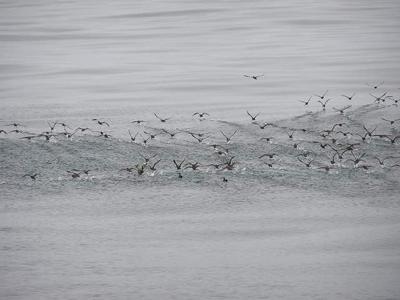
|
|
6 July, 2003
We're at sea at last! Shortly after we got underway yesterday
evening, all of scientists attended an orientation on the
ship's emergency procedures. Even though it would only be used
as a last resort, we practiced getting into our survival suits, and
then, while wearing our suits, we awkwardly boarded a life boat.
After the meeting, a few of us proceeded to the bow of the ship to
enjoy the smooth sailing and the abundant marine life in this part of
the Bering Sea. Over the course of a couple of hours, we viewed at
least 25 Humpback Whales and a Dall's Porpoise. Add to that the
thousands and thousands of seabirds that continuously pass by the
ship, it's easy to see why we are having a "whale" of a good time.
The reason why all of this wildlife is out here, of course, can be
described in one word -food. The Humpback whales feed on krill and
small fish. One hunting technique employed by the whales is to
circle their food source while releasing a wall of bubbles as they
slowly come to the surface. Once the Humpbacks have successfully
encircled their prey in this net of bubbles, they charge through with
their mouths wide open. We believed we observed this hunting
behavior on two occasions as evidenced by the feeding frenzy of
seabirds on the surface that must have been taking advantage of the
whales herding efforts. It was entertaining to watch the seabirds
suddenly scatter when the Humpbacks breeched the surface.
The seabirds are fun to observe too. The most common bird by
far that we have seen are Northern Fulmars. Fulmars belong to a
group of birds known as tubenoses. Their nostrils merge into a
single tube perched on top of their bill which allows the fulmars to
expel the salt from the sea water that they drink. We have also
observed numerous puffins, shearwaters, murres, auklets, storm
petrels, phalaropes, jaegers, guillemots, kittiwakes, murrelets,
and albatrosses.
Meanwhile, everyone continues set up their lab areas. We plan to do
some test casts (i.e. lower some oceanographic equipment into the
water) tomorrow.

A surfacing Minke Whale.

A flock of fulmars.
Contact the TEA in the field at
.
If you cannot connect through your browser, copy the
TEA's e-mail address in the "To:" line of
your favorite e-mail package.
|
